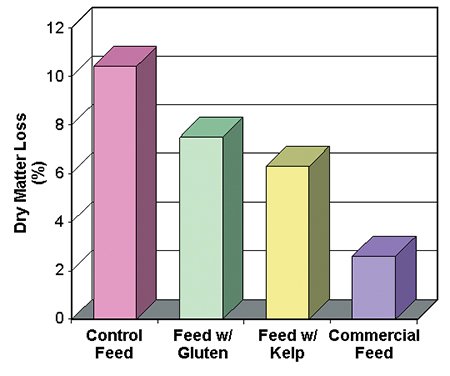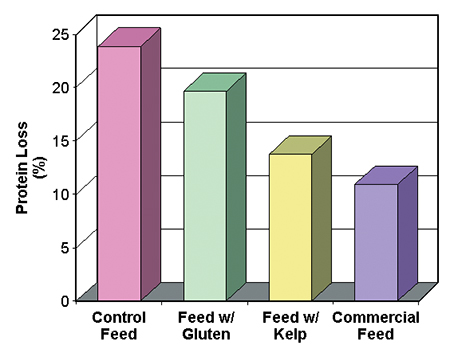Feeds with a synthetic binder had the highest water stability, followed by kelp meal


The water stability of aquatic feeds is affected by ingredients and manufacturing parameters. Among available ingredients, the source of carbohydrate and type of binder used probably have the most influence on pellet water stability. Synthetic and natural binders that provide increased water stability are often used without consideration of the final dry or wet pellet texture.
A recent study evaluated the pellet water stability and texture of four shrimp feeds manufactured using two natural binders (wheat gluten and kelp meal), one synthetic binder (Pegabind®), and a control with no binder. All feeds contained equal amounts of wheat flour as a carbohydrate source.
Feed preparation
A control feed with no binders added, and three feeds containing wheat gluten at 0.3 percent, Macrocystis pyrifera kelp meal at 3.5 percent, and a synthetic binder at 0.6 percent inclusion were manufactured in a commercial feed mill in Guayaquil, Ecuador. Table 1 shows the proximate composition of the experimental feeds.
All feeds contained 28 percent crude protein and were formulated with ingredients commonly used by the industry in Ecuador, including fish meal, wheat middlings, whole wheat meal, rice polishing, fish oil, soy lecithin, vitamins, and minerals. The ingredient mixes were ground so that 65 percent of the particles were smaller than 250 μm. The feed mashes were preconditioned for 60 seconds and pelletized at 95 degrees-C.
Feed characteristics

Dry matter loss and protein loss after one-hour immersion in 28 degrees-C seawater, and water absorption capacity were determined for pellets following standardized techniques at the Universidad Autónoma de Nuevo León Mariculture Program in Nuevo León, Mexico. The hardness, fracturability and cohesiveness of dry pellets were evaluated using a texture analyzer at the Oceanic Institute in Hawaii, USA.
Results
Water stability
In spite of the adequate water stability of the control feed (dry matter loss = 10.4 percent), significant improvements were observed with the addition of wheat gluten and kelp meal (Fig. 1). The synthetic binder reduced dry matter loss to 2.6 percent. Feed protein losses had the same pattern (Fig. 2).
Water absorption capacity
The control and feeds with wheat gluten, and kelp meal presented significantly higher water-absorption capacities than the feed with the synthetic binder. The inclusion of the natural binders probably produced a softer texture in these feeds when immersed in water.
Hardness, fracturability, cohesiveness
Feed pellets containing kelp meal had the highest hardness and fracturability in the test. Pellet cohesiveness was not significantly different among feeds. It is recommended that pellet cohesiveness be measured after feeds have been immersed in water for 30 minutes.
Conclusion
In a test of feeds with natural and synthetic binders, the feed with a synthetic binder had the highest water stability, followed by feed with kelp meal. However, water absorption capacity was reduced in pellets with the synthetic binder. Pellets containing kelp meal showed greater hardness, fracturability, and cohesiveness than the other feeds, but this did not affect water stability.
(Editor’s Note: This article was originally published in the October 2002 print edition of the Global Aquaculture Advocate.)
Now that you've finished reading the article ...
… we hope you’ll consider supporting our mission to document the evolution of the global aquaculture industry and share our vast network of contributors’ expansive knowledge every week.
By becoming a Global Seafood Alliance member, you’re ensuring that all of the pre-competitive work we do through member benefits, resources and events can continue. Individual membership costs just $50 a year. GSA individual and corporate members receive complimentary access to a series of GOAL virtual events beginning in April. Join now.
Not a GSA member? Join us.
Authors
-
Elizabeth Cruz, Ph.D.
Programa Maricultura, FCB
Universidad Autónoma de Nuevo León
Cd. Universitaria, A. P. F-56
San Nicolás de los Garza, Nuevo León, Mexico -
Denis Ricque, Ph.D.
Programa Maricultura, FCB
Universidad Autónoma de Nuevo León
Cd. Universitaria, A. P. F-56
San Nicolás de los Garza, Nuevo León, Mexico -
Mireya Tapia, Ph.D.
Programa Maricultura, FCB
Universidad Autónoma de Nuevo León
Cd. Universitaria, A. P. F-56
San Nicolás de los Garza, Nuevo León, Mexico -
Claudio Guajardo
Programa Maricultura, FCB
Universidad Autónoma de Nuevo León
Cd. Universitaria, A. P. F-56
San Nicolás de los Garza, Nuevo León, Mexico -
Leonard Obaldo, Ph.D.
The Oceanic Institute
Waimanalo, Hawaii, USA -
Mario Velasco, Ph.D.
Empacadora Nacional C.A.
Guayaquil, Ecuador -
Antonio Carrasco
Empacadora Nacional C.A.
Guayaquil, Ecuador
Tagged With
Related Posts

Health & Welfare
A case for better shrimp nutrition
Shrimp farm performance can often be below realistic production standards. Use proven nutrition, feeds and feeding techniques to improve profitability.

Responsibility
A helping hand to lend: UK aquaculture seeks to broaden its horizons
Aquaculture is an essential contributor to the world food security challenge, and every stakeholder has a role to play in the sector’s evolution, delegates were told at the recent Aquaculture’s Global Outlook: Embracing Internationality seminar in Edinburgh, Scotland.

Aquafeeds
Aquafeed supplementation with crystalline amino acids
Authors present a practical review of modern formulation options including crystalline amino acids in fulfilling nutritional requirements in aquafeeds.

Health & Welfare
Pellet stability, hardness influence feed consumption of Pacific white shrimp
A study in Ecuador found that pellet stability and the overall physical properties of feed pellets greatly influences the consumption of shrimp feeds with varied types and proportions of binder agents.


